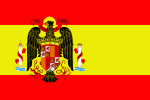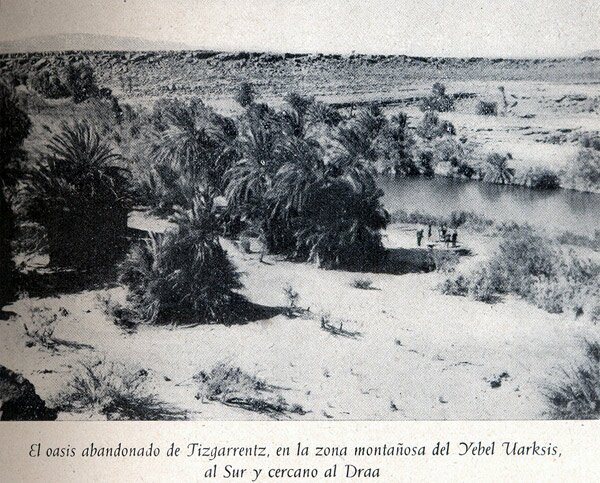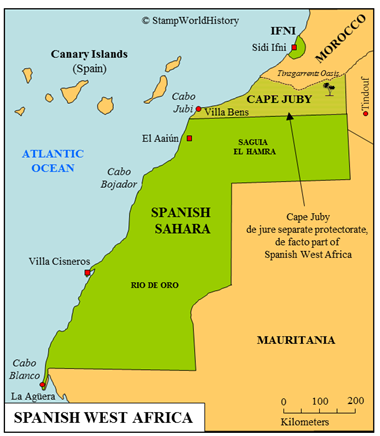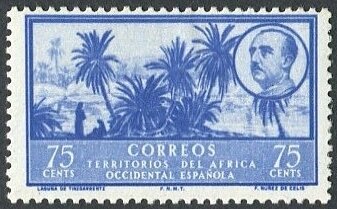
Spanish West Africa
Quick reference
General issues: Spanish colony 1949-1952
Country name on general issues: Africa Occidental Española, Territorios del Africa Occidental Español
Currency: 1 Peseta = 100 Centimos
Population: Ifni 50 000 in 1960, Spanish Sahara 76 000 in 1970
Political history Spanish West Africa
Spanish West Africa is located – other than the name suggests – in what, by United Nations standards, is northern Africa. Spanish West Africa is a Spanish colony formed in 1946 to administer the Spanish possessions of Spanish Sahara and Ifni. The territory of Ifni is a small Spanish enclave in Morocco. Ceded to the Spanish in 1860, the Spanish did not establish themselves in Ifni until 1934. Spanish Sahara was formed in 1924 – administratively integrating the colony of Rio de Oro and the territory of Saguia el Hamra. Rio de Oro was awarded to Spain as a protectorate at the 1885 Berlin conference where the colonial powers divided their respective spheres of influence in Africa. Rio de Oro was made a colony in 1900. The adjacent territory of Saguia el Hamra was annexed by Spain, in 1904, based on a treaty with the French – the major colonial power in northwestern Africa. Cape Juby – the southern part of the Spanish protectorate of Spanish Morocco – is de facto administered as a part of Spanish West Africa – although de jure it retains its status as a separate political entity.
Spanish West Africa is a desert country. The indigenous people are the Sahrawi – a Berber people. At the time of its existence, the small population depended on pastoral nomadism and – on the coast – fishing. In Ifni, the town of Sidi Ifni is founded in 1934 to become the administrative center of the Spanish possessions in the region. It is also developed as a fishing port.

The oasis of Tizgarrentz, also spelled Tinzgarrentz
Spanish West Africa is dissolved in 1958. On the one hand, the Spanish want to forestall international criticism on the slow process of decolonization by turning the Spanish possessions into Spanish provinces. Thus, the territory of Ifni and the colony of Spanish Sahara, in 1958, become Spanish provinces, the constituent parts of Spanish Sahara – the de jure still existing colony of Rio de Oro and territory of Saguia el Hamra – becoming districts of the province of Spanish Sahara. On the other hand, Morroco, has since its independence in 1956, claimed the Spanish possessions, and in 1957 asserted this claim through military force. Thus, the Spanish protectorate of Cape Juby is returned to Morocco in 1958.
Ifni will be returned to Morocco in 1969. Spanish Sahara is now commonly called Western Sahara. It is disputed between Morocco and the Sahrawi Arab Democratic Republic proclaimed by the Polisario Front – the government in exile, residing in Tindouf, just across the border in Algeria. In 1991, a cease fire is agreed upon by Morocco and the Polisario. By then, Morocco is in control of the larger part of Western Sahara – the smaller part of the country is controlled by the Polisario. A solution to the problem has yet to be found.
Postal history Spanish West Africa
Spanish West Africa has issued stamps from 1949 to 1951. Stamps that were used concurrently with the issues of Ifni and Spanish Sahara until 1952.
Album pages
← Previous page: Spanish Territories in the Gulf of GuineaNext page: Stellaland →




Gerben, I have three stamps from Spanish West Africa…. a 2 cent, 5 cent, and 10 cent in excellent condition. Do you have any idea what they are worth?
Susan
I’m afraid the stamps you have are of low value. The 2009 Michel catalog lists them at € 0.10……..